Seasteading: New Societies on the Floating Frontier
Air Date: Week of June 23, 2017
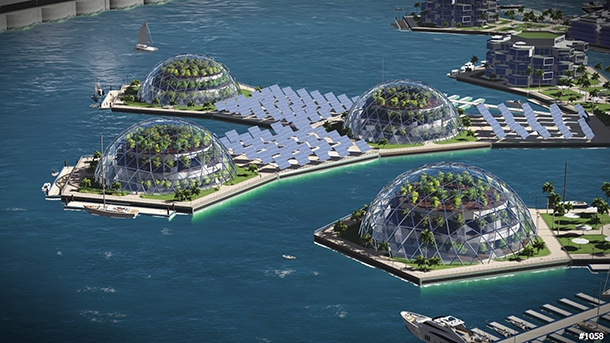
An artist’s concept of a seastead styled “Artisanopolis”, which would feature aquaponics greenhouse domes for growing food. (Photo: courtesy of Gabriel Scheare, Luke Crowley, Lourdes Crowley, and Patrick White, Chile)
California's Seasteading Institute has an audacious claim: establishing floating societies will “restore the environment, enrich the poor, cure the sick, and liberate humanity from politicians.” “Seavangelist” Joe Quirk, author of the new book Seasteading, explains this bold vision to host Steve Curwood.
Transcript
CURWOOD: It’s Living on Earth, I’m Steve Curwood.
In the 19th century many people left the crowded, costly, and often corrupt cities in the eastern US to head to the rugged frontier out west, where folks could gain independence by claiming a patch of land and working it - homesteading. Today, there is little land available in developed societies for homesteading, but that’s not an obstacle for a movement looking to create a new social, economic and political frontier by living on the ocean. They call themselves “seasteaders”. And, taking advantage of modern technology, they are looking to live on the sea beyond the crowded, costly and often corrupt countries. That’s the vision of “Seavangelist” Joe Quirk, author of the new book "Seasteading: How Floating Nations Will Restore the Environment, Enrich the Poor, Cure the Sick, and Liberate Humanity from Politicians".
Joe, welcome to Living on Earth.
QUIRK: Thanks for inviting me.
CURWOOD: Joe, how did you get involved in the seasteading movement?
QUIRK: I was at my tenth Burning Man, and anyone that watches Burning Man grow over a decade becomes fascinated by the fact that rules emerge that are not predictable from their initial parameters, and you start imagining, what if we could have more societies like these? What if they didn't just last a week, but they lasted all year round? What if we could have hundreds? What interesting ways that people could get along would we discover?
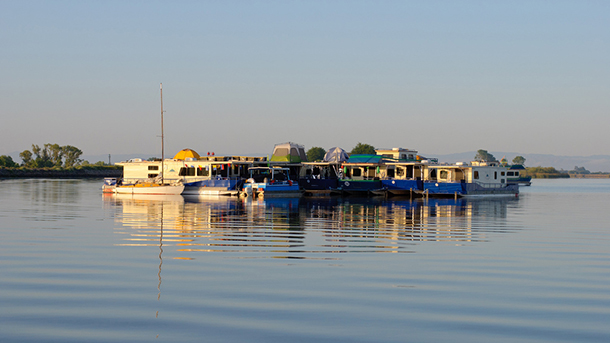
A placid morning at Ephemerisle in 2011 (Photo: Ben Chun, Flickr CC BY-SA 2.0)
And someone introduced me to Patri Friedman, and Patri Friedman told me about seasteading, and he described it as building floating cities on the sea, and as soon as I got home I noticed that the Seasteading Institute logo was based on the Burning Man logo. The Burning Man logo is basically a man with his arms to the sky, and the seasteading logo is a man with his arms to the sky with a cruise ship on top of it. And I wondered, why would cities on the ocean be inspired by a temporary city in the desert? I don't get it. What was that guy's name? Patrick Friesman? So I had to Google it. I had to figure out how to spell seastanding. and I discovered Patri's blog, and that's when I had my conversion moment.
I had just completed a book about evolution. I'd come to understand that progress comes from the magic recipe of variation and selection, and when Patri identified a problem that governance doesn't get better as quickly as other forms of technology because it doesn't vary or select except through revolution and war, and when he proposed that, if society floated and if these floating societies were disassemble-able and reassemble-able according to the choices of the residents, that would be variation by governments and selection by citizens. So, I solicited the Seasteading Institute, and said, “This can't be an obscure discussion amongst Silicon Valley bloggers. It needs to happen as soon as possible”, and I offered to co-write a populist book with Patri, not just about the ideas, but about the actual people trying to make it happen who I call “aquapreneurs”.

Patri Friedman founded the Seasteading Institute in 2008 with seed funding from PayPal founder Peter Thiel. (Photo: The Seasteading Institute)
CURWOOD: And tell me about Ephemerisle and what you've learned from this seasteading experiment there in the San Francisco area.
QUIRK: About here after the Seasteading Institute was founded, we kickstarted Ephemerisle with combines “ephemera” with “islands”, and it's basically a yearly festival in the Sacramento Delta which has been described as Burning Man on the water, and if you want to attend you have to bring your own land. So people rent boats, they get giant platforms, anything that can be put together to float, and the idea was that as people learn the lessons of living together on the water and solve technical challenges, it would slowly expand and move out to the sea.
CURWOOD: Now, when you tell the story of Ephemerisle, you guys come together, but then you split apart. What happened?
QUIRK: So, for about three years it was all peace and harmony, and by 2011 conflicts began to emerge. The people who wanted to dance and party clashed with the people who wanted to do a lecture series. The people who behaved like children clashed with the adults who brought children, and we had a big argument about what the real Ephemerisle was all about. By 2012, Ephemerisle split up into three islands and people with different ideas formed their little separate jurisdictions, and, no sooner were people living on separate islands, then a taxi system was spontaneously organized among the islands and everyone got along very well, and by the next year after that, some of the islands that fought most of all reached a compromise and rejoined.

The Seasteading logo was styled on the Burning Man logo (a man with arms raised). (Photo: The Seasteading Institute)
So, the social principles of seasteading have been demonstrated in microcosm at Ephemerisle, exactly as originally described by Patri Freedman, where he elucidated that if you lived on the fluid frontier and land was modular and disassemble-able, people who didn't get along could go vote with their house and go form their own separate jurisdiction. And as long as people could choose among them voluntarily, we think we'd create many different solutions for how to live together that would set examples that could change the world.
CURWOOD: Now, let's talk about the technology here, or rather, I should say “engineering.” It's certainly easy enough to have a floating platform in fairly shallow water but the part of the Earth that is ungoverned is deep ocean and parts of it have hundred foot waves at times. How do you engineer cities on the sea?
QUIRK: You are correct. Building in shallow waters is possible right now, and it's already been done on a small scale. Building in high waves is so expensive that only fossil fuel companies can afford it. So, how do we scale up?
We're starting in French Polynesia. We're negotiating with them to create a special, legal island known as a "sea zone" in their territorial waters so we can apply existing Dutch technology for sustainable floating islands in shallow waters to demonstrate the business model, two or three pilot platforms in a very small and nonthreatening way, such that we would absorb the risk, and if we succeed this could good bring prosperity to French Polynesians.

Seasteads like “Water-Scraper,” above, can be engineered to remain stable even in deep water and rough seas, says Quirk, by concentrating the bulk of their mass below the surface. (Photo: courtesy of Sarly Adre Sarkum, Nik Syazwan Nik Ab. Wahab, Amy Roshida Othman, Ahmad Azri Idrus, Muhamad Zharif Amir Sharifudin, Malaysia)
If it succeeds, we could attach more platforms in very shallow waters and what makes French Polynesia such an ideal place to start is that it's close enough to the equator that it doesn't experience high waves. It's very warm waters. It's not threatened by cyclones, and it is blessed with lots of natural wave breakers from atolls to lagoons and it also has lots of very deep water. This is the blue frontier where we can expand seasteading incrementally.
CURWOOD: Joe, I enjoy being on the ocean, but you know there are times, may I say, when it's a bit choppy. I mean, how comfortable are people going to be living at sea where things could be moving all the time?
QUIRK: You absolutely need to solve the seasickness problem if you're going to create civilization on the sea. I was on a cruise ship once, and I call it the "martini test", where if I can sit on the dock and order a martini and they can pour it right to the brim and it doesn't spill then I am in civil society.
CURWOOD: Although after the third martini you might not care.
QUIRK: [LAUGHS] I can create my own seasickness, but I'd rather the oceans not do it for me. And I've also watched elderly people putting on putting greens and playing miniature golf on cruise chips. Even oil platforms in very high waves are frequently stable enough for people to play ping-pong, and the solutions are known, and they're already in operation in some structures on the sea.
Basically you put a huge amount of ballast deep below the the ocean such that most of the mass is several hundred meters below the ocean. Then you can put your actual city up on pilings just as you can build a foundation on land, you can build a foundation on the ocean. And 60 feet above the waves, where they can get quite high, you can create a very stable platform, and if you're listeners are interested, they could look up the “flip ship” – “f”-“i”-“l”-“p” - which has been in operation on the ocean since 1962, and it has this deep ballast beneath the ocean such that only one sixth of the flip ship is above the ocean and it's been described as being as stable as a fence post in 60 foot waves. If you set up four flips and put a platform on it, you could create a very stable platform on the high oceans.
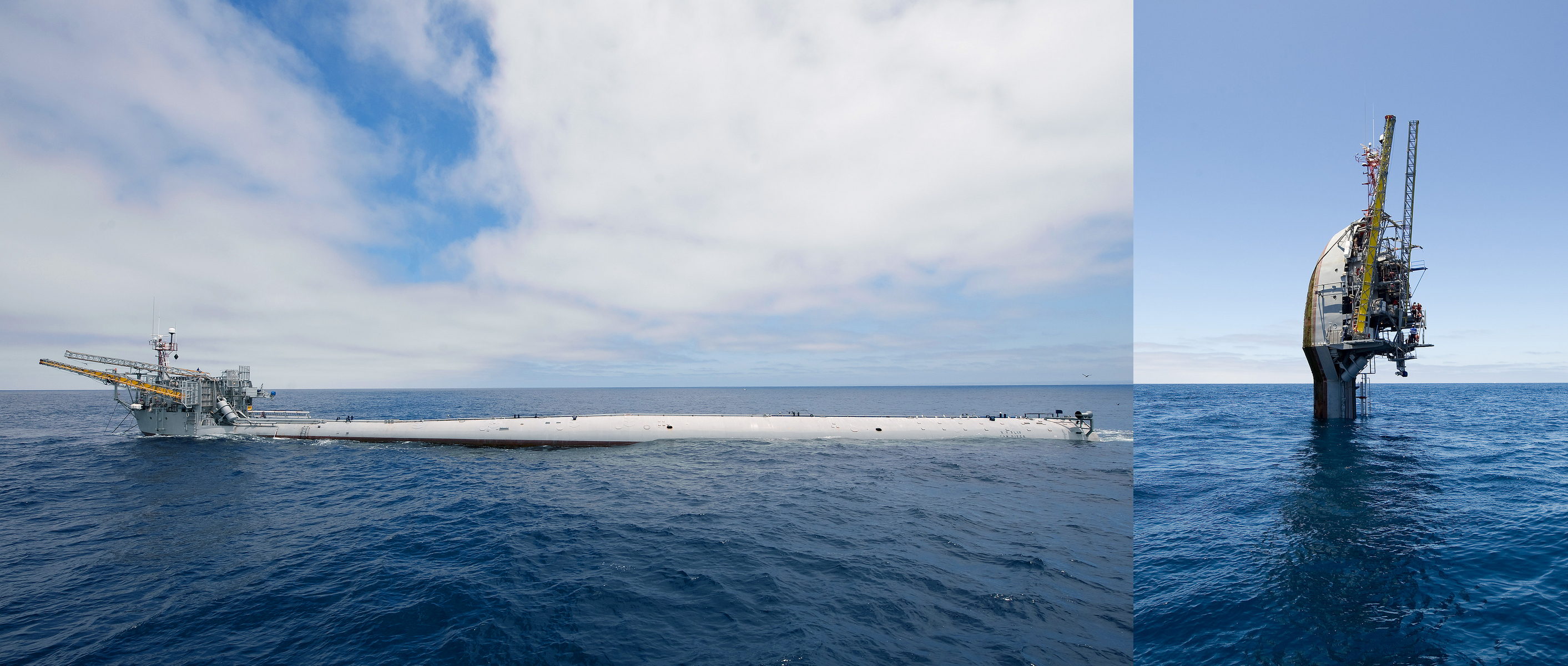
When turned on end, only 1/6 of the 355 feet of the FLIP (Floating Instrument Platform) ship poke above the surface of the ocean, providing great stability. (Photo: John F. Williams/U.S. Navy, Flickr CC BY 2.0)
CURWOOD: Joe, surely these floating nations are going to require a lot of construction material. How can that be sustainable?
QUIRK: Well, seasteading requires you to completely rethink the assumption we bring to land-based cities, which are generally not sustainable, they require huge amounts of wheat and corn and soy which cause all sorts of nutrient runoff emptying into the seas which often give rise to dead zones. But if you're floating cities in the ocean, you have to rethink all these assumptions. For instance, our initial floating islands could provide a home for sea life. They could reduce the sunlight that reaches the sea floor by just a few degrees, enough to lower the temperature of the surrounding waters, which could be enough to spark the restoration of the corals. As they scale up and go out into deeper waters, they could actually increase the amount of green life on the oceans.
The oceans are essentially a desert. Most of the nutrient wealth sinks below where photosynthesis can reach, so there's very little sea life out there, and less than one percent of the ocean is where most of the fish are fished because the fisherman rely on upwellings from the deep ocean which strike, say, islands or coasts and then drive up all this nutrient wealth. So, imagine if your cities increased the amount of greenery in the world, increased the number of ecosystems in the world, and provided a huge carbon sink. Algae is a larger carbon sink than the rainforests of the world, and it's comparatively easy to chop up seaweed, drop it to the deep ocean floor and remove it from the biosphere for tens of millions of years.
CURWOOD: Now, what about the fact that our tastebuds, our human tastebuds are accustomed to all sorts of things we get off the land - the wheat and corn and swiss chard and, for those who eat meat, the livestock. How are you going to get that at sea?

A modular wavebreaker would shelter the proposed Artisanopolis seasted in shallow coastal waters. (Photo: courtesy of Gabriel Scheare, Luke Crowley, Lourdes Crowley, and Patrick White, Chile)
QUIRK: Chances are pretty strong that the wheat or corn that you ate today was fertilized with algae, and we already eat algae every day. Algae products are in our toothpaste, it's in our beer, it's in our peanut butter. So, algae food already permeate the food eat every day, and they even nourish the land crops we eat every day, and the idea is to continue scaling this up on the seas. Seaweed and algae haven't undergone the artificial selection that have made corn, wheat and soy so tremendously productive. A lot of algae contains complete proteins, contain all the best fats, and Ricardo Radulovich who wants to scale up massive seaweed farms on the ocean imagines we could conceivably bioengineer or artificially select for sea crops to taste like tomatoes. There's a whole new world of healthier, more sustainable food that we have not developed yet, far beyond wheat, corn, and soy.
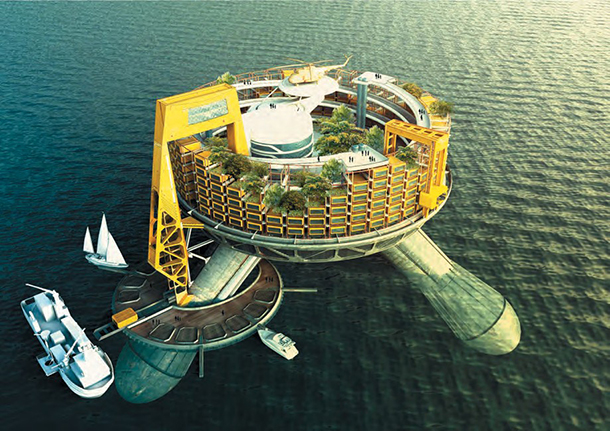
The first permanent businesses on the high seas could be sovereign floating hospitals that provide cutting-edge care to patients who choose them. (Photo: design concept by Edward McIntosh, 2014, Ecuador)
CURWOOD: Joe, let's cut to the chase though. There are some folks who, you know, they get up in the morning at the campsite especially they want that bacon.
[LAUGHS]
QUIRK: They might be interested in the bacon of the sea. So, somebody discovered that the seaweed dulse if smoked in a certain way tastes like bacon. And this been tested on gourmet chefs and gourmands who love to eat, and this just gives you a little hint of the types of foods we can develop using sea crops which are much more diverse and much healthier than the land crops we currently eat.
CURWOOD: Joe, how do you envision health care could change if people had access to floating medical care?
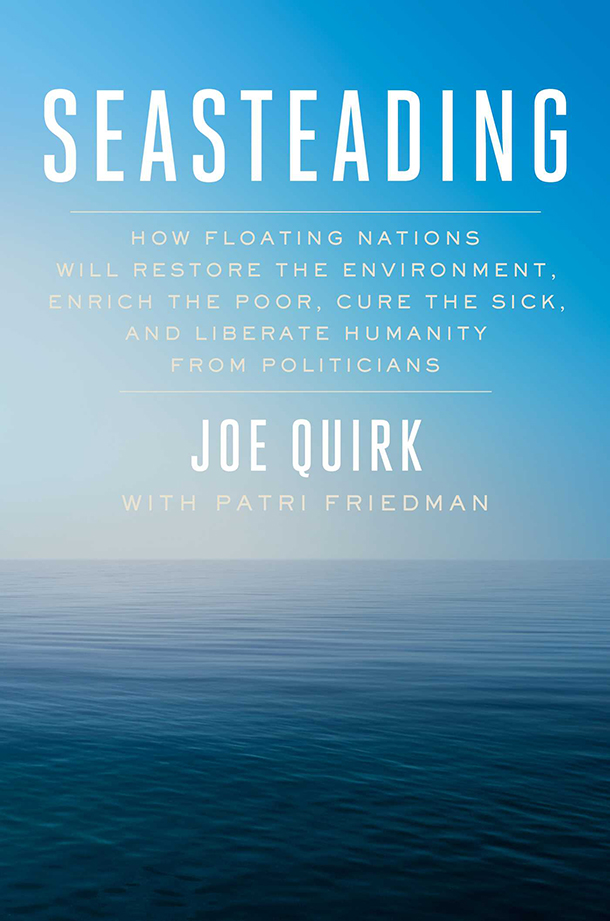
Joe Quirk and Patri Friedman’s book is called Seasteading: How Floating Nations Will Restore the Environment, Enrich the Poor, Cure the Sick, and Liberate Humanity from Politicians. (Photo: Simon and Schuster)
QUIRK: There should be more options than just national health care. The great thing about seasteading is that if you like your government, you can keep your government. But if other people can try other systems that could potentially work better and absorb the risk of that, we could learn something new about the kind of health care that's possible in the 21st century. Lots of medical entrepreneurs and physicians have reached out to the Seasteading Institute, saying, if you can provide me a seastead just off the coast of an existing American city, I could provide much better, much more humane, much cheaper and more efficient health care, if you guys can provide this for me.
CURWOOD: Now, you mention French Polynesia. A little further south in the Pacific are a number of nations that are threatened with innundation from the climate disruption. I'm thinking of Tuvalu, Kiribati, the list goes on. How much of a solution is your approach of seasteading in those places?
QUIRK: One of the biggest problems in the world is sea level change threatening coastal countries and especially Pacific island countries. Seasteading is an immediate solution to this problem. French Polynesia sees itself as the blue frontier, and they are initiating the blue economy, and they want to get this started in French Polynesia to demonstrate that this can work.
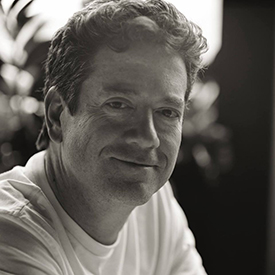
Joe Quirk is the “Seavangelist” of the Seasteading Institute as well as a science writer, novelist, and memoir ghostwriter. (Photo: courtesy of Joe Quirk)
Next door to French Polynesia is Kiribati, which is scheduled to sink below sea level before the end of this century. And you can imagine that as the islands sink they could steadily transition into become floating islands, especially since the islands will be just below the surface of the ocean, and you can tether to them. Then they would be called seamounts, and once that precedent is set, and our seasteading lawyers argue on the floor of the United Nations that Kiribati still deserves sovereignty even though they don't have physical islands left, you can imagine another floating nation being built somewhere next door. If people like these flooding nations and they are no threat to the world and they're providing better solutions and they are as delightful as cruise ships, I think we have a humanitarian case to petition the nations of the world, to recognize these floating nations as sovereign.
CURWOOD: Joe Quirk's new book is called "Seasteading: How Floating Nations Will Restore the Environment, Enrich the Poor, Cure the Sick, and Liberate Humanity from Politicians". Joe, thanks so much for taking the time with me today.
QUIRK: Thank you for inviting me. I really enjoyed the conversation.
Links
Living on Earth wants to hear from you!
Living on Earth
62 Calef Highway, Suite 212
Lee, NH 03861
Telephone: 617-287-4121
E-mail: comments@loe.org
Newsletter [Click here]
Donate to Living on Earth!
Living on Earth is an independent media program and relies entirely on contributions from listeners and institutions supporting public service. Please donate now to preserve an independent environmental voice.
NewsletterLiving on Earth offers a weekly delivery of the show's rundown to your mailbox. Sign up for our newsletter today!
 Sailors For The Sea: Be the change you want to sea.
Sailors For The Sea: Be the change you want to sea.
 The Grantham Foundation for the Protection of the Environment: Committed to protecting and improving the health of the global environment.
The Grantham Foundation for the Protection of the Environment: Committed to protecting and improving the health of the global environment.
 Contribute to Living on Earth and receive, as our gift to you, an archival print of one of Mark Seth Lender's extraordinary wildlife photographs. Follow the link to see Mark's current collection of photographs.
Contribute to Living on Earth and receive, as our gift to you, an archival print of one of Mark Seth Lender's extraordinary wildlife photographs. Follow the link to see Mark's current collection of photographs.
 Buy a signed copy of Mark Seth Lender's book Smeagull the Seagull & support Living on Earth
Buy a signed copy of Mark Seth Lender's book Smeagull the Seagull & support Living on Earth

